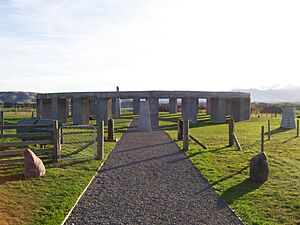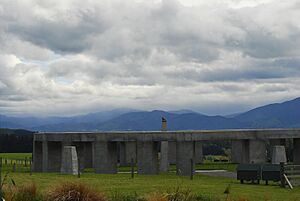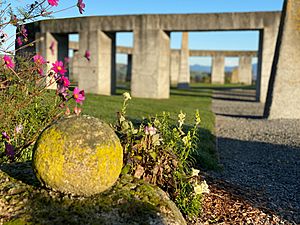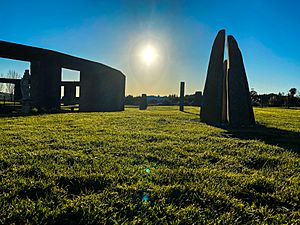Stonehenge Aotearoa facts for kids
Stonehenge Aotearoa is a special place in Wairarapa, New Zealand. It's like a giant outdoor classroom for learning about the stars and planets. This place is inspired by the famous Stonehenge in England, but it's a modern version built to teach us about astronomy. It's designed especially for its spot in New Zealand's North Island.
A person named Richard Hall, who studies stars (an astronomer), wanted to create a place where people could learn about space, rocks, and science. He started a group called The Phoenix Astronomy Society. This group worked hard to build Stonehenge Aotearoa. Many volunteers helped out, giving thousands of hours of their time to make it happen.
The building of Stonehenge Aotearoa took two years. It officially opened on February 12, 2005. A very important scientist, Professor Alan MacDiarmid, who won a Nobel Prize, was there for the opening.
What is Stonehenge Aotearoa Like?
This special structure has 24 tall pillars and is about 30 meters (100 feet) wide. The pillars are about 4 meters (13 feet) high. Big stones called lintels connect the tops of the pillars, making a full circle.
Near the middle, there's a tall, thin stone called an obelisk, which is about 5 meters (16 feet) high. From the obelisk, there's a special 10-meter area called the analemma. This area helps show how the Sun's position changes throughout the year.
You enter Stonehenge Aotearoa through a path called a causeway that leads to the center. Outside the main circle, there are six heel stones of different heights.
Why Was It Built?
Stonehenge Aotearoa was built to show how ancient people used structures like this to understand the sky. It helps explain basic ideas about astronomy, which is the study of space. Visitors can learn about the knowledge that was important for people long ago. This knowledge helped them survive by knowing when to plant crops or when seasons would change.
This modern henge also teaches about the "star compass." This was a tool used by Polynesian Navigators to travel across the ocean. The pillars are not all the same distance apart. Their positions point to important stars that helped with navigation and marked different seasons.
Unlike the original Stonehenge in England, the pillars and lintels here are not solid carved stones. Instead, they are hollow structures made with concrete. If you stand in the middle of Stonehenge Aotearoa, the pillars and lintels look like doorways. These "doorways" frame where the Sun, Moon, and bright stars rise. These stars were important for telling time or finding directions.
Seasons and Stars
As our Earth travels around the Sun, its north and south poles tilt. This tilt causes the Sun to appear higher or lower in the sky during the year. This is why we have different seasons.
The six heel stones at Stonehenge Aotearoa show where the Sun rises and sets during special times of the year. These times are called solstices (the longest and shortest days) and equinoxes (when day and night are equal).
There is a stone sculpture called "the Fingers of Mother Earth." This sculpture marks the spot where you can see the star cluster Matariki rise. Matariki is important in Māori culture and appears around the winter solstice in June.






